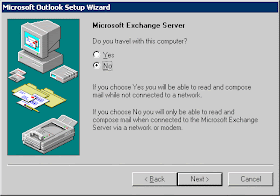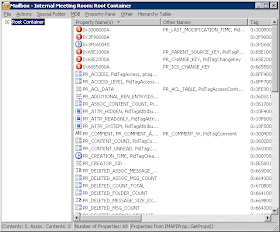User A sends meeting request to User B and receives NDR - unable to send to User C. User C used to be listed as a delegate in User B's Outlook (Tools/Options/Delegates) but is no longer there in outlook. User C left the company some time ago.
Resolution (Easy Method)
The easy method to resolve this issue is to recreate the User B's mailbox. Do not recreate his account, if you do this he will get a new GUID however the Distinguished Name will remain same. Everyone has in their user profile an NK2 file that aligns DN to GUID. If the GUID changes but the DN remains the same, whenever someone emails that user they will recieve a bounce back saying Recipient Object Not found. Outlook trys to send to the wrong GUID. The only way to fix this is to remove the entry from every users NK2 file in the organisation or tell the users to delete their NK2 file so PLEASE dont delete the user account. Instead disconnect the mailbox and create a new mailbox linked to the account.
Resolution (Hard Method)
This is a bug with the Outlook client not displaying the correct information from what is stored in the exchange mailbox database. The only way to fix such situations is to use an advanced MAPI editing tool to crack open mailbox that contains the calendar and remove the delegate manually using a tool called MFCMAPI. This lets you see the schema inside the exchange information store database and modify attribute values by hand. MFCMAPI can cause irreversible damage to a user’s mailbox and should only be used by advanced exchange administrators that understand the workings of the MAPI protocol and the fields that are used to store information inside a user’s mailbox.
MFCMAPI was originally a Microsoft tool but has now been taken over by a 3rd party however the documentation for MFCMAPI still exists on Microsoft Technet. Download MCFMAPI from:
http://mfcmapi.codeplex.com
Before we make changes to a user mailbox or a resource mailbox such as a calendar back it up using ExMerge to a PST file!
Download ExMerge from here:
http://www.microsoft.com/downloads/details.aspx?FamilyId=429163EC-DCDF-47DC-96DA-1C12D67327D5&displaylang=en
Note: Ex-Merge can only be used for exchange 2000/2003
Now we are ready to start. Follow these steps.
1. Open MCFMAPI on either a client workstation with Outlook installed or on the Exchange server itself and connect to a profile:

2. If your on a client workstation with outlook there, your profile will already be there just select it and hit OK. If your on the Exchange Server there will not be any profiles in place so click New to create one.

3. Choose Microsoft Exchange Server

4. Provide a profile name, I think its a good idea to call the profile the same as the mailbox name to make it easy to reference.

5. Enter the name of your exchange mailbox server and the mailbox your trying to edit.

6. Choose no.

7. Click finish

8. We now have a connection to the Internal Meeting Room mailbox just like outlook does in the backend. We are able to view the public folders available to this user along with the mailbox resource. We are interested in the mailbox as this is where the delegate information is stored. Open the mailbox store by right clicking and hitting Open Store.

9. This is what a mailbox looks like.

10. Expand out Root Container --> Top of Information Store --> Inbox. Note if they have any folders under their inbox they will appear as sub folders in the list here. Right click on the Inbox folder and click Display Rules Table.

The Rules Table on the Inbox is where all outlook rules and alerts as well as delegations get stored. I will show you this on my computer... I have a rule in my outlook client... this is what it looks like in MFCMAPI.

However the list also contains delegates. How do I tell if a rule is a delegate? Well I found on the following technet article http://technet.microsoft.com/en-us/library/bb508857(EXCHG.65).aspx it says:
"If a delegate rule is configured on a mailbox, the PR_RULE_PROVIDER property is Schedule+EMS Interface."
11. Using this information found on Technet locate the delegate rules on the mailboxes that are not displaying the delegates in outlook. We can see that this rule (that has no name) is a delegate for the fact its property is "Schedule+EMS Interface"

12. Delete the rule its the one causing problems!

Great post. This really helped resolve a year old problem that I could not solve.
ReplyDeleteThanks again.
Thanks alot. This worked for me too :-)
ReplyDeleteThank you so much, It solved an issue my customer had.
ReplyDelete